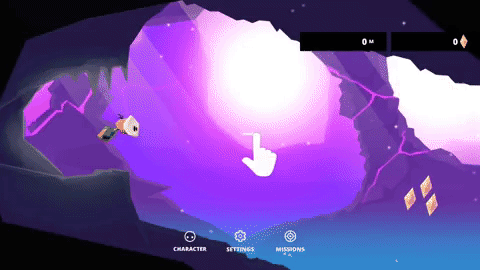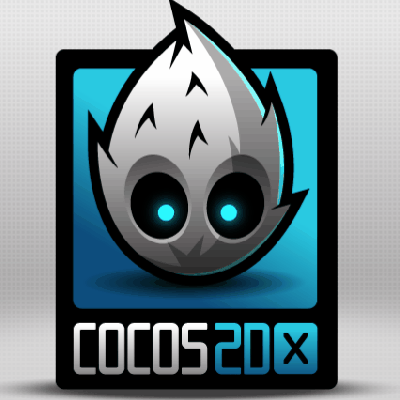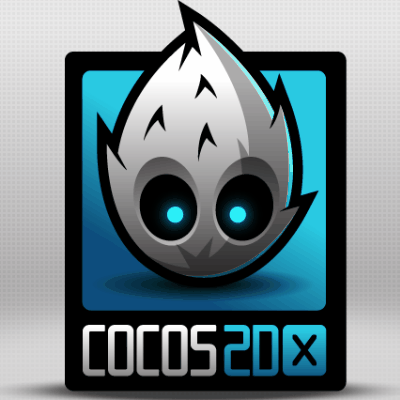After studying "Post-Processing Effects in Cocos2d-X" and "RENDERTEXTURE + BLUR", I came along to the following solution.
The common way to achieve post processing effects in Cocos2s-X is to implement layers. The scene is one layer, and a post process is another layer, which uses the scene layer as an input. With this technique, the post process can manipulate the rendered scene.
The blur algorithm is implemented in a shader. A common way to apply a blur effect on a scene is to blur first along he X-axis of the viewport and in an second pass along the Y-axis of the viewport (see ShaderLesson5). This is an acceptable approximations, which gives a massive gain of performance.
This means, that we need 2 post process layers in Cocos2s-X. So wee need 3 layers, one for the scene and 2 for the post processes:
// scene (game) layer
m_gameLayer = Layer::create();
this->addChild(m_gameLayer, 0);
// blur X layer
m_blurX_PostProcessLayer = PostProcess::create("shader/blur.vert", "shader/blur.frag");
m_blurX_PostProcessLayer->setAnchorPoint(Point::ZERO);
m_blurX_PostProcessLayer->setPosition(Point::ZERO);
this->addChild(m_blurX_PostProcessLayer, 1);
// blur y layer
m_blurY_PostProcessLayer = PostProcess::create("shader/blur.vert", "shader/blur.frag");
m_blurY_PostProcessLayer->setAnchorPoint(Point::ZERO);
m_blurY_PostProcessLayer->setPosition(Point::ZERO);
this->addChild(m_blurY_PostProcessLayer, 2);
Note, the sprites and resources of the scene have to be added to m_gameLayer.
In the updated methode, the post processes have to be apllied to the scene (I'll describe the setup of the uniforms later):
// blur in X direction
cocos2d::GLProgramState &blurXstate = m_blurX_PostProcessLayer->ProgramState();
blurXstate.setUniformVec2( "u_blurOffset", Vec2( 1.0f/visibleSize.width, 0.0 ) );
blurXstate.setUniformFloat( "u_blurStrength", (float)blurStrength );
m_blurX_PostProcessLayer->draw(m_gameLayer);
// blur in Y direction
cocos2d::GLProgramState &blurYstate = m_blurY_PostProcessLayer->ProgramState();
blurYstate.setUniformVec2( "u_blurOffset", Vec2( 0.0, 1.0f/visibleSize.height ) );
blurYstate.setUniformFloat( "u_blurStrength", (float)blurStrength );
m_blurY_PostProcessLayer->draw(m_blurX_PostProcessLayer);
For the management of the post process I implemented a class PostProcess, where I tried to keep things as simple as possible:
PostProcess.hpp
#include <string>
#include "cocos2d.h"
class PostProcess : public cocos2d::Layer
{
private:
PostProcess(void) {}
virtual ~PostProcess() {}
public:
static PostProcess* create(const std::string& vertexShaderFile, const std::string& fragmentShaderFile);
virtual bool init(const std::string& vertexShaderFile, const std::string& fragmentShaderFile);
void draw(cocos2d::Layer* layer);
cocos2d::GLProgram & Program( void ) { return *_program; }
cocos2d::GLProgramState & ProgramState( void ) { return *_progState; }
private:
cocos2d::GLProgram *_program;
cocos2d::GLProgramState *_progState;
cocos2d::RenderTexture *_renderTexture;
cocos2d::Sprite *_sprite;
};
PostProcess.cpp
#include "PostProcess.hpp"
using namespace cocos2d;
bool PostProcess::init(const std::string& vertexShaderFile, const std::string& fragmentShaderFile)
{
if (!Layer::init()) {
return false;
}
_program = GLProgram::createWithFilenames(vertexShaderFile, fragmentShaderFile);
_program->bindAttribLocation(GLProgram::ATTRIBUTE_NAME_COLOR, GLProgram::VERTEX_ATTRIB_POSITION);
_program->bindAttribLocation(GLProgram::ATTRIBUTE_NAME_POSITION, GLProgram::VERTEX_ATTRIB_COLOR);
_program->bindAttribLocation(GLProgram::ATTRIBUTE_NAME_TEX_COORD, GLProgram::VERTEX_ATTRIB_TEX_COORD);
_program->bindAttribLocation(GLProgram::ATTRIBUTE_NAME_TEX_COORD1, GLProgram::VERTEX_ATTRIB_TEX_COORD1);
_program->bindAttribLocation(GLProgram::ATTRIBUTE_NAME_TEX_COORD2, GLProgram::VERTEX_ATTRIB_TEX_COORD2);
_program->bindAttribLocation(GLProgram::ATTRIBUTE_NAME_TEX_COORD3, GLProgram::VERTEX_ATTRIB_TEX_COORD3);
_program->bindAttribLocation(GLProgram::ATTRIBUTE_NAME_NORMAL, GLProgram::VERTEX_ATTRIB_NORMAL);
_program->bindAttribLocation(GLProgram::ATTRIBUTE_NAME_BLEND_WEIGHT, GLProgram::VERTEX_ATTRIB_BLEND_WEIGHT);
_program->bindAttribLocation(GLProgram::ATTRIBUTE_NAME_BLEND_INDEX, GLProgram::VERTEX_ATTRIB_BLEND_INDEX);
_program->link();
_progState = GLProgramState::getOrCreateWithGLProgram(_program);
_program->updateUniforms();
auto visibleSize = Director::getInstance()->getVisibleSize();
_renderTexture = RenderTexture::create(visibleSize.width, visibleSize.height);
_renderTexture->retain();
_sprite = Sprite::createWithTexture(_renderTexture->getSprite()->getTexture());
_sprite->setTextureRect(Rect(0, 0, _sprite->getTexture()->getContentSize().width,
_sprite->getTexture()->getContentSize().height));
_sprite->setAnchorPoint(Point::ZERO);
_sprite->setPosition(Point::ZERO);
_sprite->setFlippedY(true);
_sprite->setGLProgram(_program);
_sprite->setGLProgramState(_progState);
this->addChild(_sprite);
return true;
}
void PostProcess::draw(cocos2d::Layer* layer)
{
_renderTexture->beginWithClear(0.0f, 0.0f, 0.0f, 0.0f);
layer->visit();
_renderTexture->end();
}
PostProcess* PostProcess::create(const std::string& vertexShaderFile, const std::string& fragmentShaderFile)
{
auto p = new (std::nothrow) PostProcess();
if (p && p->init(vertexShaderFile, fragmentShaderFile)) {
p->autorelease();
return p;
}
delete p;
return nullptr;
}
The shader needs a unifor which contains the offset for the blur algorithm (u_blurOffset). This is the distance between 2 pixels along the X-axis for the first blur pass and the distance between 2 texels along the Y-axis for the second blur pass.
The strength of the blur effect is setup by the uniform variable (u_blurStrength). Where 0.0 means that blurring is off and 1.0 means maximum blurring. The maximum blur effect is defined by the value of MAX_BLUR_WIDHT, which defines the range of the texels wich are looked on in each direction. So this is more or less the blur radius. If you increase the value, the blur effect will increase, at the disadvantage of a loss of performance. If you decrease the value the blur effect will decrease, but you will winn performance. The relation between performance and the value of MAX_BLUR_WIDHT is thankfully linear (and not quadratic), because of the approximated 2 pass implementation.
I decided to avoid pre calculating gauss weights and passing them to the shader (the gauss weights would depend on MAX_BLUR_WIDHT and u_blurStrength). Instead I used a smooth Hermite interpolation similar to the GLSL function smoothstep:
blur.vert
attribute vec4 a_position;
attribute vec2 a_texCoord;
attribute vec4 a_color;
varying vec4 v_fragmentColor;
varying vec2 v_texCoord;
void main()
{
gl_Position = CC_MVPMatrix * a_position;
v_fragmentColor = a_color;
v_texCoord = a_texCoord;
}
blur.frag
varying vec4 v_fragmentColor;
varying vec2 v_texCoord;
uniform vec2 u_blurOffset;
uniform float u_blurStrength;
#define MAX_BLUR_WIDHT 10
void main()
{
vec4 color = texture2D(CC_Texture0, v_texCoord);
float blurWidth = u_blurStrength * float(MAX_BLUR_WIDHT);
vec4 blurColor = vec4(color.rgb, 1.0);
for (int i = 1; i <= MAX_BLUR_WIDHT; ++ i)
{
if ( float(i) >= blurWidth )
break;
float weight = 1.0 - float(i) / blurWidth;
weight = weight * weight * (3.0 - 2.0 * weight); // smoothstep
vec4 sampleColor1 = texture2D(CC_Texture0, v_texCoord + u_blurOffset * float(i));
vec4 sampleColor2 = texture2D(CC_Texture0, v_texCoord - u_blurOffset * float(i));
blurColor += vec4(sampleColor1.rgb + sampleColor2.rgb, 2.0) * weight;
}
gl_FragColor = vec4(blurColor.rgb / blurColor.w, color.a);
}
The full C++ and GLSL source code can be found on GitHub (The implementation can be activated by bool HelloWorld::m_blurFast = false).
See the preview:
![preview]()
Separate shader for each blur radius
A high performance version of an gaussian blur algorithm is the solution presented at GPUImage-x. In this implementation a separated blur shader for each blur radius is created. The source code of the full cocos2d-x demo implementation can be found at GitHub.The implementation provides 2 variants, the standard implementation and the optimized implementation, like the implementation in the link, which can be set up by bool GPUimageBlur::m_optimized. The implementation generates a shader for each radius from 0 to int GPUimageBlur::m_maxRadius and a sigma float GPUimageBlur::m_sigma.
See the preview:
![preview]()
Fast limited quality blur
A much more powerful solution, but with obvious very low quality, would be to use the shader presented at Optimizing Gaussian blurs on a mobile GPU. The blurring is not dynamic and can only be switched on or off:
update methode:
// blur pass 1
cocos2d::GLProgramState &blurPass1state = m_blurPass1_PostProcessLayer->ProgramState();
blurPass1state.setUniformVec2( "u_blurOffset", Vec2( blurStrength/visibleSize.width, blurStrength/visibleSize.height ) );
m_gameLayer->setVisible( true );
m_blurPass1_PostProcessLayer->draw(m_gameLayer);
m_gameLayer->setVisible( false );
// blur pass 2
cocos2d::GLProgramState &blurPass2state = m_blurPass2_PostProcessLayer->ProgramState();
blurPass2state.setUniformVec2( "u_blurOffset", Vec2( blurStrength/visibleSize.width, -blurStrength/visibleSize.height ) );
m_blurPass1_PostProcessLayer->setVisible( true );
m_blurPass2_PostProcessLayer->draw(m_blurPass1_PostProcessLayer);
m_blurPass1_PostProcessLayer->setVisible( false );
Vetex shader:
attribute vec4 a_position;
attribute vec2 a_texCoord;
varying vec2 blurCoordinates[5];
uniform vec2 u_blurOffset;
void main()
{
gl_Position = CC_MVPMatrix * a_position;
blurCoordinates[0] = a_texCoord.xy;
blurCoordinates[1] = a_texCoord.xy + u_blurOffset * 1.407333;
blurCoordinates[2] = a_texCoord.xy - u_blurOffset * 1.407333;
blurCoordinates[3] = a_texCoord.xy + u_blurOffset * 3.294215;
blurCoordinates[4] = a_texCoord.xy - u_blurOffset * 3.294215;
}
Fragment shader
varying vec2 blurCoordinates[5];
uniform float u_blurStrength;
void main()
{
vec4 sum = vec4(0.0);
sum += texture2D(CC_Texture0, blurCoordinates[0]) * 0.204164;
sum += texture2D(CC_Texture0, blurCoordinates[1]) * 0.304005;
sum += texture2D(CC_Texture0, blurCoordinates[2]) * 0.304005;
sum += texture2D(CC_Texture0, blurCoordinates[3]) * 0.093913;
sum += texture2D(CC_Texture0, blurCoordinates[4]) * 0.093913;
gl_FragColor = sum;
}
See the preview:
![enter image description here]()
The full C++ and GLSL source code can be found on GitHub (The implementation can be switched by bool HelloWorld::m_blurFast).
Progressive solution with two layers (frame buffers)
The idea of this solution is, to do a smooth, progressive, high quality blur of the scene. For this a weak, but fast and high quality blur algorithm is need. A blurry sprite is not deleted, it will be stored for the next refresh of the game engine and is used as source for the next blurring step. This means the weak blurry sprite, again gets blurry and so it is a little bit more blurry than the last one. This is a progressive process which end in a strong and exact blurred sprite.
To set up this process 3 layers are of need, the game layer and 2 blur layers (even and odd).
m_gameLayer = Layer::create();
m_gameLayer->setVisible( false );
this->addChild(m_gameLayer, 0);
// blur layer even
m_blur_PostProcessLayerEven = PostProcess::create("shader/blur_fast2.vert", "shader/blur_fast2.frag");
m_blur_PostProcessLayerEven->setVisible( false );
m_blur_PostProcessLayerEven->setAnchorPoint(Point::ZERO);
m_blur_PostProcessLayerEven->setPosition(Point::ZERO);
this->addChild(m_blur_PostProcessLayerEven, 1);
// blur layer odd
m_blur_PostProcessLayerOdd = PostProcess::create("shader/blur_fast2.vert", "shader/blur_fast2.frag");
m_blur_PostProcessLayerOdd->setVisible( false );
m_blur_PostProcessLayerOdd->setAnchorPoint(Point::ZERO);
m_blur_PostProcessLayerOdd->setPosition(Point::ZERO);
this->addChild(m_blur_PostProcessLayerOdd, 1);
Note, that initially all 3 layers are invisible.
In the update` method one layer is set to state visible. If there is no blurring, then the game layer is visible. Once blurring starts, the game layer is rendered to the even layer, with the blur shader. The game layer becomes invisible and the even layer becomes visible. In the next cycle the even layer is rendered to the odd layer, with the blur shader. The even layer becomes invisible and the odd layer becomes visible. This process continues till blurring is stopped. Meanwhile, the scene becomes blurred stronger and stronger, at high quality.
If the original scene has to show again, then the game layer has be set to visible and the even and odd layer have to be set invisible.
update methode:
bool even = (m_blurTick % 2) == 0;
if ( m_blur )
{
cocos2d::GLProgramState &blurFaststate1 = m_blur_PostProcessLayerEven->ProgramState();
blurFaststate1.setUniformVec2( "u_texelOffset", Vec2( 1.0f/visibleSize.width, 1.0f/visibleSize.height ) );
cocos2d::GLProgramState &blurFaststate2 = m_blur_PostProcessLayerOdd->ProgramState();
blurFaststate2.setUniformVec2( "u_texelOffset", Vec2( -1.0f/visibleSize.width, -1.0f/visibleSize.height ) );
if ( m_blurTick == 0 )
{
m_gameLayer->setVisible( true );
m_blur_PostProcessLayerEven->draw(m_gameLayer);
}
else if ( even )
{
m_blur_PostProcessLayerEven->draw(m_blur_PostProcessLayerOdd);
}
else
{
m_blur_PostProcessLayerOdd->draw(m_blur_PostProcessLayerEven);
}
++m_blurTick;
}
else
m_blurTick = 0;
m_gameLayer->setVisible( !m_blur );
m_blur_PostProcessLayerEven->setVisible( m_blur && even );
m_blur_PostProcessLayerOdd->setVisible( m_blur && !even );
The shader is a simple and exact 3*3 blur shader:
Vetex shader:
attribute vec4 a_position;
attribute vec2 a_texCoord;
varying vec2 blurCoordinates[9];
uniform vec2 u_texelOffset;
void main()
{
gl_Position = CC_MVPMatrix * a_position;
blurCoordinates[0] = a_texCoord.st + vec2( 0.0, 0.0) * u_texelOffset.st;
blurCoordinates[1] = a_texCoord.st + vec2(+1.0, 0.0) * u_texelOffset.st;
blurCoordinates[2] = a_texCoord.st + vec2(-1.0, 0.0) * u_texelOffset.st;
blurCoordinates[3] = a_texCoord.st + vec2( 0.0, +1.0) * u_texelOffset.st;
blurCoordinates[4] = a_texCoord.st + vec2( 0.0, -1.0) * u_texelOffset.st;
blurCoordinates[5] = a_texCoord.st + vec2(-1.0, -1.0) * u_texelOffset.st;
blurCoordinates[6] = a_texCoord.st + vec2(+1.0, -1.0) * u_texelOffset.st;
blurCoordinates[7] = a_texCoord.st + vec2(-1.0, +1.0) * u_texelOffset.st;
blurCoordinates[8] = a_texCoord.st + vec2(+1.0, +1.0) * u_texelOffset.st;
}
Fragment shader:
varying vec2 blurCoordinates[9];
void main()
{
vec4 sum = vec4(0.0);
sum += texture2D(CC_Texture0, blurCoordinates[0]) * 4.0;
sum += texture2D(CC_Texture0, blurCoordinates[1]) * 2.0;
sum += texture2D(CC_Texture0, blurCoordinates[2]) * 2.0;
sum += texture2D(CC_Texture0, blurCoordinates[3]) * 2.0;
sum += texture2D(CC_Texture0, blurCoordinates[4]) * 2.0;
sum += texture2D(CC_Texture0, blurCoordinates[5]) * 1.0;
sum += texture2D(CC_Texture0, blurCoordinates[6]) * 1.0;
sum += texture2D(CC_Texture0, blurCoordinates[7]) * 1.0;
sum += texture2D(CC_Texture0, blurCoordinates[8]) * 1.0;
sum /= 16.0;
gl_FragColor = sum;
}
Again, the full C++ and GLSL source code can be found on GitHub.
See the preview:
![enter image description here]()





